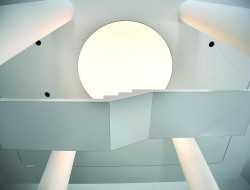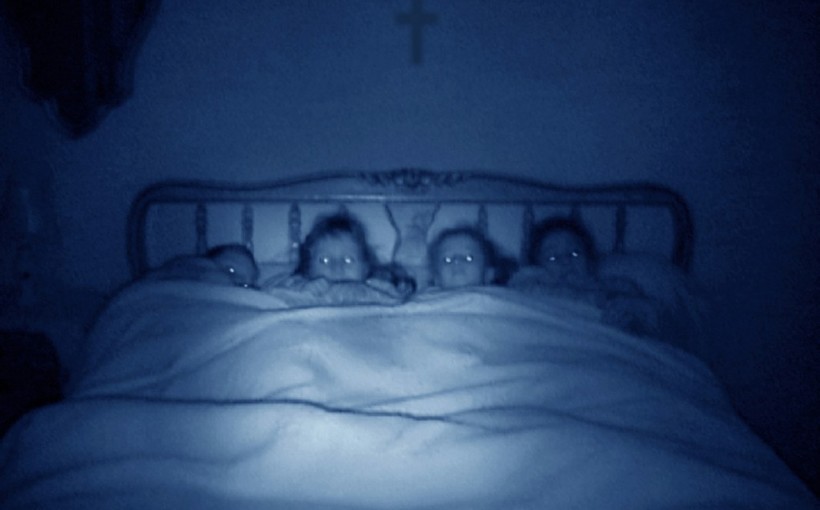artists: Lucas & Jason Ajemian (US), Archive of an Anonymous Ghost-Seer (DE), curated by hans w. koch, Sam Ashley (US), Corinne May Botz (US), Erik Bünger (SE), Damien Cadio (FR), Nina Fischer/Maroan el Sani (DE), Agnès Geoffray (FR), Kathrin Günter (DE), Carl Michael von Hausswolff (SE), Tim Hecker (CA), Martin Howse (GB), International Necronautical Society (GB), Friedrich Jürgenson (SE), Joep van Liefland (NL), Chris Marker (FR), Jorge Queiroz (PT), Scanner (GB), Jan Peter E.R. Sonntag (DE), Suzanne Treister (GB)
curators: Inke Arns & Thibaut de Ruyter
(Thomas Schütte)*
The Awake Are Only the Spirits exhibition, organized in cooperation with Hartware MedienKunstVerein (HMKV) in Dortmund where it presented in 2009, bases on the audio archive of Friedrich Jürgenson who discovered the so-called Electronic Voice Phenomenon (EVP) in 1959. The projects reflects upon different ‚ghosts’ stories’, questionning why – despite our faith in the rational – at regular intervals irrational properties are ascribed to respective new media and technologies, such as those purportedly serving as channels for messages from ‘the beyond’.
According to the curators of the exhibition, the project was based on the archive of Friedrich Jürgenson, which encompasses some eight hundred reels of tape. Thanks to the efforts of the Swedish artist Carl Michael von Hausswolff, the archive was placed in the keeping of the ZKM Center for Art and Media, Karlsruhe, several years ago, and has been given to Harware MedienKunstVerein as a loan. The exhibition also allows us to present the archive, dating from the 1980s, of an anonymous Aachen-based researcher whose investigation of EVP phenomena was not confined to the acoustic realm. Using the most recent video technology (then analogue still), the researcher was able to record the images of deceased persons purportedly discerned on the screen of a running television set. The two archives serve as a point of departure for an exhibition of contemporary art that explores the question of whether ghosts exist, the ways in which new media and technologies are deployed in spiritist circles, and the political implications and the aesthetics of such contemporary transcommunication phenomena.
Taking as starting point the lively interest shown in the subject by contemporary artists, the show aims to explore why, for all our enlightenment, irrational capabilities are regularly ascribed to the new media and technologies of a given time. Put in general terms, all of the projects by the twenty participating artists deal in some way or another with the making visible or perceptible of the invisible.
Corinne May Botz (USA) photographed in the USA a series of ‘haunted houses’ that compound, when presented as a series, into one typical ‘ur-haunted house’. Nina Fischer & Maroan el Sani (Germany) use Kirlian photographic techniques to photograph the auras of past usages in historically charged rooms. In their respective mediums of painting and photography, Damien Cadio and Agnès Geoffray (both France) disclose the deeply uncanny in everyday pictures, while Kathrin Günter (Germany) makes visible by means of a self-made (or self-converted) Polaroid camera the residual light in the human eye. Carl Michael von Hausswolff (Sweden), Martin Howse (GB), Sam Ashley (USA) and Scanner (GB) have all built actual ‘ghost detectors’. All manner of re-purposed equipment stands to attention, ready to react to the slightest sign of change (in the electromagnetic field, humidity, skin-resistance, and so forth), and in this way indicate a presence. Jan-Peter E.R. Sonntag (Germany) transfers electromagnetic weather anomalies into his Warden Sprites, an installation made specially for the show, by making light-bulbs and fluorescent tubes light up without cables, a method reminiscent of what became known as ‘Tesla light’. Wireless, altogether, the new buzzword. Wirelessness – the fact, that is, that we can dip into ‘data clouds’ almost everywhere (‘warchalking’), that we are surrounded by the all-encompassing internet – inspires, even more than the internet, notions of the ‘ghostliness’ of the new media. Using her own specific media archaeology, Suzanne Treister (GB) digs through to the finest historical ramifications of these new media and in this way exposes the occult roots of the military (and civil) technologies of the present day.
Lucas & Jason Ajemijan (USA), Tim Hecker (Canada), Scanner (GB) and Joep van Liefland (Netherlands) explore the aesthetic of white noise and the messages it conceals. While the Ajemijan brothers investigate the phenomenon of ‘backwards messages’ using a practical example, the experimental musician Tim Hecker devotes himself to political propaganda and its counter-propaganda by combining audio recordings of the Cuban state radio broadcaster Radio Havana with material from Radio Marti, an anti-Castro station broadcasting from Miami. Scanner’s new sound piece Phantom Signals is based on recordings of a psychic medium communicating with the eighteenth-century author Jane Austen and unknown muffled voices found on the artist’s mobile telephone. In Donald Judd Faces of Death, Joep van Liefland confronts the philosophy of minimalism with the aesthetic of noise.
Jorge Queiroz (Portugal) and Chris Marker (France) deal with the structure of memory and visual recollection and the linguistic and mental processes by which they are constituted. While Chris Marker’s classic work Immemory charts the depths of human recollection, Jorge Queiroz uses automatic writing to draw ‘mental maps’ accentuating the significance of the unconscious. In his video 17 June 1972, he adapts an EVP researcher’s recordings, previously found by chance on a cassette tape for music, into a soundtrack to underscore his maps.
A further core subject area addressed by Erik Bünger (Sweden) and the International Necronautical Society (GB) is the phenomenon of the dislocated human voice. In his Lecture on Schizophonia, Erich Bünger examines the deeply unsettling phenomenon of the detachment of the voice from its body, using very early phonographic recordings up to works of contemporary pop culture. The International Necronautical Society has captured various spoken texts with flight-recording equipment, on the Black Box normally used to document the dialogue in a cockpit in the minutes leading up to a crash. The installation of that name transmits the recordings from the CoCA onto the airwaves over a specific shortwave frequency.
*Substituting ‘Geist’ (spirit) for ‘Geiz’(stinginess), Thomas Schütte turns a popular marketing slogan into ‘Ghosts are groovy’.
 The Institution is funded from the budget of Toruń Municipality
The Institution is funded from the budget of Toruń Municipality



